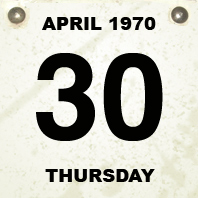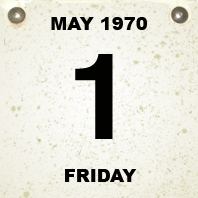|
APRIL 30- RIOTS CONTINUE Thursday, April 30 was another long day. The situation was now aggravated by outsiders who had heard about the previous day’s events on the news and flocked to campus looking for excitement. Out-of-town radicals, bikers, gang members, high school kids, and assorted thrill-seekers now joined the fray. These groups had no interest in campus issues. They just wanted to cause trouble and play chase with law enforcement. The morning found large crowds gathering at Neil and 12th and Chittenden and Indianola. Sheriff’s deputies and National Guardsmen dispersed these crowds and tore down the barricades they tried to build in the streets. The authorities labored under a hail of verbal abuse, rocks, bricks, bottles, and garbage. Around 10, a huge crowd of about 3,000 assembled on The Oval in front of the Administration Building. A line of Guardsmen with loaded weapons and fixed bayonets greeted them. For the next two hours, the protestors abused and pushed the Guardsmen until the Guard drove them back with tear gas. As soon as the tear gas abated, the crowd returned to be driven back again. This continued into the afternoon. Throughout the day, anarchy reigned. Police, state troopers and Guardsmen were kept busy dispersing mobs that gathered at Indianola and 15th, High and Chittenden, Lane and High, and Neil and 11th. Rioters taunted law enforcement with obscenities and cries of "Pigs!" and pelted them rocks and bricks. Tear gas was used widely on campus, along High Street and in the neighborhoods. Shotguns were fired and beatings freely administered. Rioters added a new element to the disorder when they began setting vehicles on fire and starting bonfires in busy intersections. Small fires were set in several campus buildings and the constant triggering of fire alarms added to the confusion. In the evening, someone set off a firebomb in Brown Hall. Unconfirmed reports claimed firemen arriving to put out these blazes were assaulted by rioters. Hanging over all was the rumor of impending mass carnage. Heavily armed motorcycle gangs were reported to be massing in the area south of King for a rampage through campus. Terrorists from the Weather Underground were said to be on campus planting bombs in university buildings. The city banned all alcohol and gasoline sales in the university area and extended the area and duration of the curfew. Sales of firearms and ammunition were banned citywide. For people living and working in the University District, the situation was nightmarish. The stench of smoke and tear gas hung heavy in the air. Yards were wrecked and sidewalks torn up by rioters looking for missiles or barricades. Roving vandals destroyed or defaced whatever they came across. Workers were unable to get to or from their jobs. Schools were closed. Area businesses were forced to close and had to deal with vandalism and theft. Property owners feared for their buildings while residents feared for their lives. Thursday's toll was 32 police injured, 2 Guardsmen injured, 28 civilians injured, and over 200 arrested.
|
|
|
MAY 1- A BREAK Friday saw clouds and rain as an unseasonable cold front approached the area. The change in the weather cooled the passions of rioters. A gathering of about 3,000 protestors was held on the Oval but no violence occurred. Observers noted that demonstrators seemed exhausted from the week's events. Student and faculty marshals also must be credited. The marshals worked hard to defuse confrontations and deescalate tensions. At great personal risk, they placed themselves between protesters and law enforcement, trying to keep people from getting hurt or hurting others. Downtown, the jail was overflowing with prisoners and Municipal Court struggled to work through the hundreds of arrests made in the previous two days. Meanwhile, the university and city bemoaned the rising price of the disorder. The National Guard's presence on campus was costing $30,000 a day ($158,000 in current dollars). The Columbus Police Department had used up thousands of dollars in tear gas. Bills for police, patrolmen, sheriff's deputies, and firemen would add tens of thousands more. |
|
|
||



